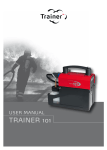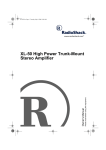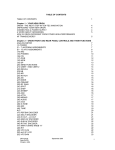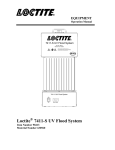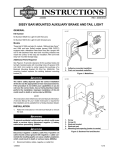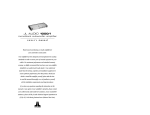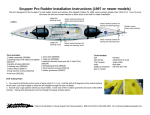Download POWER DISTRIBUTION SYSTEMS
Transcript
POWER DISTRIBUTION SYSTEMS DN 8O - 1 POWER DISTRIBUTION SYSTEMS TABLE OF CONTENTS page page DESCRIPTION AND OPERATION POWER DISTRIBUTION SYSTEM. . . . . . . . . . . . . 1 POWER DISTRIBUTION CENTER . . . . . . . . . . . . . 1 GENERATOR CARTRIDGE FUSE . . . . . . . . . . . . . . 2 JUNCTION BLOCK . . . . . . . . . . . . . . . . . . . . . . . . 2 IGNITION-OFF DRAW FUSE . . . . . . . . . . . . . . . . . 3 RELAY AND FUSE BLOCK . . . . . . . . . . . . . . . . . . 4 REMOVAL AND INSTALLATION POWER DISTRIBUTION CENTER . . . . . . . . . . . . . 4 GENERATOR CARTRIDGE FUSE . . . . . . . . . . . . . . 6 JUNCTION BLOCK . . . . . . . . . . . . . . . . . . . . . . . . 6 IGNITION-OFF DRAW FUSE . . . . . . . . . . . . . . . . . 7 RELAY AND FUSE BLOCK . . . . . . . . . . . . . . . . . . 8 DESCRIPTION AND OPERATION electrical distribution points for the vehicle technician to use when conducting diagnosis and repair of faulty circuits. The power distribution system can also prove useful for the sourcing of additional electrical circuits that may be required to provide the electrical current needed to operate many accessories that the vehicle owner may choose to have installed in the aftermarket. POWER DISTRIBUTION SYSTEM DESCRIPTION This group covers the various standard and optional power distribution components used on this model. The power distribution system for this vehicle consists of the following components: • Power Distribution Center (PDC) • Junction Block (JB) • Relay and Fuse Block. The power distribution system also incorporates various types of circuit control and protection features, including: • Automatic resetting circuit breakers • Blade-type fuses • Cartridge fuses • Circuit splice blocks • Flashers • Relays. Following are general descriptions of the major components in the power distribution system. See the owner’s manual in the vehicle glove box for more information on the features and use of all of the power distribution system components. Refer to the index in this service manual for the location of complete circuit diagrams for the various power distribution system components. OPERATION The power distribution system for this vehicle is designed to provide safe, reliable, and centralized distribution points for the electrical current required to operate all of the many standard and optional factory-installed electrical and electronic powertrain, chassis, safety, security, comfort and convenience systems. At the same time, the power distribution system was designed to provide ready access to these POWER DISTRIBUTION CENTER DESCRIPTION Fig. 1 Power Distribution Center Location 1 2 3 4 5 6 7 8 – – – – – – – – CLIP BATTERY TRAY NEGATIVE CABLE POSITIVE CABLE CLIP FENDER INNER SHIELD POWER DISTRIBUTION CENTER All of the electrical current distributed throughout this vehicle is directed through the standard equipment Power Distribution Center (PDC) (Fig. 1). The molded plastic PDC housing is located in the left 8O - 2 POWER DISTRIBUTION SYSTEMS DN DESCRIPTION AND OPERATION (Continued) front corner of the engine compartment, just behind the battery. The PDC houses the generator cartridge fuse and up to ten maxi-type cartridge fuses, which replace all in-line fusible links. The PDC also houses up to seven blade-type mini fuses, up to thirteen International Standards Organization (ISO) relays (one standard-type and twelve micro-type), two joint connectors (one sixteen-way and one twenty-six-way) and a sixteen-way engine wire harness in-line connector. The PDC housing is secured in the engine compartment at three points. Integral mounts on the front and inboard sides of the PDC housing engage and latch to stanchions that are integral to the molded plastic battery tray. An integral bracket on the rear of the PDC housing is secured with a screw to the top of the left front inner wheel house. The PDC housing has a molded plastic cover that includes two integral latches, one on each side. The PDC cover is easily opened and removed for service access and has a convenient fuse and relay layout map integral to the inside surface of the cover to ensure proper component identification. The PDC unit cannot be repaired and is only serviced as a unit with the headlamp and dash wire harness. If the internal circuits or the PDC housing are faulty or damaged, the headlamp and dash wire harness unit must be replaced. nals. The generator cartridge fuse cannot be repaired and, if faulty or damaged, it must be replaced. OPERATION The generator cartridge fuse is secured between the two B(+) terminal stud connection bus bars within the Power Distribution Center (PDC). This fuse protects the vehicle electrical system from damage that could be caused by excessive charging system output and/or excessive electrical system current levels resulting from a faulty generator or faulty charging system control circuits. If the current rating of the fuse is exceeded, the fuse conductor melts to open the generator output circuit connection to the PDC. If a generator cartridge fuse fails, be certain to completely inspect and test the vehicle charging system before replacing the fuse and returning the vehicle to service. Refer to Charging System in the index of this service manual for the charging system diagnostic procedures. Refer to Power Distribution in the index of this service manual for the location of complete PDC circuit diagrams. JUNCTION BLOCK DESCRIPTION OPERATION All of the current from the battery and the generator output enters the PDC through two cables with eyelets that are secured with nuts to the two B(+) terminal studs located just inside the inboard side of the PDC housing. The PDC cover is unlatched and removed to access the battery and generator output connection B(+) terminal studs, the fuses, the relays, the joint connectors and the engine wire harness inline connector. Internal connection of all of the PDC circuits is accomplished by an intricate combination of hard wiring and bus bars. Refer to Power Distribution in the index of this service manual for the location of complete PDC circuit diagrams. GENERATOR CARTRIDGE FUSE DESCRIPTION A 140 ampere generator cartridge fuse is used on this model. The generator cartridge fuse is similar to other cartridge fuses found in the Power Distribution Center (PDC). This fuse has a color-coded plastic housing and a clear plastic fuse conductor inspection cover like other cartridge fuses, but has a higher current rating and is connected and secured with screws instead of being pushed onto male spade-type termi- Fig. 2 Junction Block Location 1 – FUSE ACCESS PANEL 2 – JUNCTION BLOCK 3 – INSTRUMENT PANEL An electrical Junction Block (JB) is concealed behind the left outboard end of the instrument panel cover (Fig. 2). The JB serves to simplify and centralize numerous electrical components, and to distribute electrical current to many of the accessory systems in the vehicle. It also eliminates the need for numerous splice connections and serves in place of a bulkhead connector between many of the engine compartment, instrument panel, and body wire harnesses. The JB DN POWER DISTRIBUTION SYSTEMS 8O - 3 DESCRIPTION AND OPERATION (Continued) houses up to nineteen blade-type fuses (two standard-type and seventeen mini-type), up to two bladetype automatic resetting circuit breakers, and two International Standards Organization (ISO) relays (one standard-type and one micro-type). The molded plastic JB housing has integral mounting brackets that are secured with two screws to the left instrument panel end bracket. The left end of the instrument panel cover has a snap-fit fuse access panel that can be removed for service of the JB. A fuse puller and spare fuse holders are located on the back of the fuse access cover, as well as an adhesivebacked fuse layout map to ensure proper fuse identification. The JB unit cannot be repaired and is only serviced as an assembly. If any internal circuit or the JB housing is faulty or damaged, the entire JB unit must be replaced. OPERATION All of the circuits entering and leaving the JB do so through up to nine wire harness connectors, which are connected to the JB through integral connector receptacles molded into the JB housing. Internal connection of all of the JB circuits is accomplished by an intricate combination of hard wiring and bus bars. Refer to Junction Block in the index of this service manual for the location of complete JB circuit diagrams. IGNITION-OFF DRAW FUSE DESCRIPTION All vehicles are equipped with an Ignition-Off Draw (IOD) fuse (Fig. 3) that is disconnected within the Junction Block (JB) when the vehicle is shipped from the factory. Dealer personnel are to reconnect the IOD fuse in the JB as part of the preparation procedures performed just prior to new vehicle delivery. The left end of the instrument panel cover has a snap-fit fuse access panel that can be removed to provide service access to the fuses in the JB. A finger recess is molded into the access panel for easy removal. An adhesive-backed fuse layout map is secured to the instrument panel side of the access panel to ensure proper fuse identification. The IOD fuse is a 15 ampere mini blade-type fuse. The fuse is secured within a black molded plastic fuse holder and puller unit that serves both as a tool for disconnecting and reconnecting the fuse in its JB cavity, and as a fuse holder that conveniently stores the fuse in the same JB cavity after it has been disconnected. Fig. 3 Ignition-Off Draw Fuse - Typical 1 – JUNCTION BLOCK 2 – IGNITION-OFF DRAW FUSE AND HOLDER 3 – LEFT INSTRUMENT PANEL END BRACKET OPERATION The term ignition-off draw identifies a normal condition where power is being drained from the battery with the ignition switch in the Off position. The IOD fuse feeds the memory and sleep mode functions for some of the electronic modules in the vehicle as well as various other accessories that require battery current when the ignition switch is in the Off position, including the clock. The only reason the IOD fuse is disconnected is to reduce the normal IOD of the vehicle electrical system during new vehicle transportation and pre-delivery storage to reduce battery depletion, while still allowing vehicle operation so that the vehicle can be loaded, unloaded and moved as needed by both vehicle transportation company and dealer personnel. The IOD fuse is disconnected from JB fuse cavity 12 when the vehicle is shipped from the assembly plant. Dealer personnel must reconnect the IOD fuse when the vehicle is being prepared for delivery in order to restore full electrical system operation. Once the vehicle is prepared for delivery, the IOD function of this fuse becomes transparent and the fuse that has been assigned the IOD designation becomes only another Fused B(+) circuit fuse. The IOD fuse serves no useful purpose to the dealer technician in the service or diagnosis of any vehicle system or condition, other than the same purpose as that of any other standard circuit protection device. 8O - 4 POWER DISTRIBUTION SYSTEMS DN DESCRIPTION AND OPERATION (Continued) The IOD fuse can be used by the vehicle owner as a convenient means of reducing battery depletion when a vehicle is to be stored for periods not to exceed about thirty days. However, it must be remembered that disconnecting the IOD fuse will not eliminate IOD, but only reduce this normal condition. If a vehicle will be stored for more than about thirty days, the battery negative cable should be disconnected to eliminate normal IOD; and, the battery should be tested and recharged at regular intervals during the vehicle storage period to prevent the battery from becoming discharged or damaged. Refer to Battery in the index of this service manual for the location of additional service information covering the battery. RELAY AND FUSE BLOCK DESCRIPTION The relay and fuse block components are accessed for service by removing the steering column opening cover from the instrument panel. The relay and fuse block is then disengaged from the JB mounting tabs and pulled out from under the instrument panel. Service replacement of the relay and fuse block unit requires instrument panel assembly removal. The relay and fuse block unit cannot be repaired and is only serviced as a unit with the instrument panel wire harness assembly. If the relay and fuse block housing or its internal circuits are faulty or damaged, the entire instrument panel wire harness unit must be replaced. OPERATION The relay and fuse block is integral to the instrument panel wire harness, and all circuits entering or leaving this module do so through the instrument panel wire harness. Internal connection of all of the relay and fuse block circuits is accomplished by hard wiring. Refer to Fuse/Fuse Block in the index of this service manual for the location of complete circuit diagrams and cavity assignments for the relay and fuse block. REMOVAL AND INSTALLATION POWER DISTRIBUTION CENTER The Power Distribution Center (PDC) is serviced as a unit with the headlamp and dash wire harness. If any internal circuit of the PDC or the PDC housing is faulty or damaged, the entire PDC and headlamp and dash wire harness unit must be replaced. REMOVAL Fig. 4 Relay and Fuse Block Location 1 – JUNCTION BLOCK 2 – RELAY AND FUSE BLOCK The relay and fuse block is snap fit onto mounting tabs located on the end of the Junction Block (JB) nearest to the dash panel, under the left outboard end of the instrument panel (Fig. 4). The relay and fuse block provides additional capacity for distribution and control of electrical current for some of the accessory systems that are unique to this vehicle, and which could not be accommodated by the JB or the Power Distribution Center (PDC). The relay and fuse block has cavities for up to four additional blade-type mini fuses, the electronic combination flasher, and three additional International Standards Organization relays (one standard-type and two micro-type). (1) Disconnect and isolate the battery negative cable. (2) Disconnect each of the headlamp and dash wire harness connectors. Refer to Connector Locations in the index of this service manual for the location of more information on the headlamp and dash wire harness connector locations. (3) Remove all of the fasteners that secure each of the headlamp and dash wire harness ground eyelets to the vehicle body and chassis components. Refer to Connector Locations in the index of this service manual for the location of more information on the ground eyelet locations. (4) Disengage each of the retainers that secure the headlamp and dash wire harness to the vehicle body and chassis components. Refer to Connector Locations in the index of this service manual for the location of more information on the headlamp and dash wire harness retainer locations. (5) Unlatch and remove the cover from the PDC. POWER DISTRIBUTION SYSTEMS DN 8O - 5 REMOVAL AND INSTALLATION (Continued) (6) Disconnect the engine wire harness in-line connector from the PDC connector receptacle (Fig. 5). Fig. 5 Engine Wire Harness In-Line Connector 1 2 3 4 – – – – COVER POWER DISTRIBUTION CENTER ENGINE WIRE HARNESS IN-LINE CONNECTOR CLIP (7) Slide the engine wire harness retainer clip upward and disengage the harness from the trough on the rear of the PDC housing. (8) Remove the nut that secures the eyelet of the battery negative cable generator output take out to the rearward B(+) terminal stud in the PDC and remove the eyelet from the stud (Fig. 6). (9) Remove the nut that secures the eyelet of the battery positive cable PDC take out to the forward B(+) terminal stud in the PDC and remove the eyelet from the stud. (10) Remove the screw that secures the PDC housing to the left front fender wheel housing (Fig. 7). (11) Disengage the latches for the two PDC mounts and lift the unit off of the battery tray stanchions. (12) Remove the PDC and the headlamp and dash wire harness from the engine compartment as a unit. Fig. 6 Battery and Generator Connections to PDC 1 2 3 4 5 – – – – – POWER DISTRIBUTION CENTER COVER NUT BATTERY POSITIVE CABLE PDC TAKE OUT BATTERY NEGATIVE CABLE GENERATOR OUTPUT TAKE OUT 6 – NUT INSTALLATION NOTE: If the PDC is being replaced with a new unit, be certain to transfer each of the blade-type fuses, cartridge fuses and relays from the faulty PDC to the proper cavities of the replacement PDC. Refer to Power Distribution in the index of this service manual for the location of complete PDC circuit diagrams and cavity assignments. Fig. 7 Power Distribution Center Remove/Install 1 2 3 4 – – – – POWER DISTRIBUTION CENTER BATTERY TRAY LEFT FRONT FENDER WHEEL HOUSING SCREW 8O - 6 POWER DISTRIBUTION SYSTEMS DN REMOVAL AND INSTALLATION (Continued) (1) Position the PDC and the headlamp and dash wire harness unit in the engine compartment. (2) Install the two PDC mounts onto the two stanchions of the battery tray. (3) Install and tighten the screw that secures the PDC housing to the left front fender wheel housing. Tighten the screw to 7.9 N·m (70 in. lbs.). (4) Install the eyelet of the battery positive cable PDC take out onto the forward B(+) terminal stud in the PDC. (5) Install and tighten the nut that secures the eyelet of the battery positive cable PDC take out to the forward B(+) terminal stud in the PDC. Tighten the nut to 9 N·m (80 in. lbs.). (6) Install the eyelet of the battery negative cable generator output take out onto the rearward B(+) terminal stud in the PDC. (7) Install and tighten the nut that secures the eyelet of the battery negative cable generator output take out to the rearward B(+) terminal stud in the PDC. Tighten the nut to 9 N·m (80 in. lbs.). (8) Engage the engine wire harness in the trough on the back of the PDC housing and secure it with the retainer clip. (9) Reconnect the engine wire harness in-line connector to the PDC in-line connector receptacle. (10) Install and latch the cover onto the PDC. (11) Engage each of the retainers that secure the headlamp and dash wire harness to the vehicle body and chassis components. Refer to Connector Locations in the index of this service manual for the location of more information on the headlamp and dash wire harness retainer locations. (12) Install all of the fasteners that secure each of the headlamp and dash wire harness ground eyelets to the vehicle body and chassis components. Refer to Connector Locations in the index of this service manual for the location of more information on the ground eyelet locations. (13) Reconnect each of the headlamp and dash wire harness connectors. Refer to Connector Locations in the index of this service manual for the location of more information on the headlamp and dash wire harness connector locations. (14) Reconnect the battery negative cable. GENERATOR CARTRIDGE FUSE If a generator cartridge fuse fails, be certain to inspect and test the vehicle charging system before replacing the cartridge fuse and returning the vehicle to service. Refer to Charging System in the index of this service manual for the charging system diagnostic procedures. REMOVAL (1) Disconnect and isolate the battery negative cable. (2) Unlatch and remove the cover from the Power Distribution Center (PDC). (3) Remove the two screws that secure the generator cartridge fuse to the two B(+) terminal stud bus bars within the PDC. (4) Remove the generator cartridge fuse from the PDC. INSTALLATION (1) Position the generator cartridge fuse onto the two B(+) terminal stud bus bars within the PDC. (2) Install and tighten the two screws that secure the generator cartridge fuse to the two B(+) terminal stud bus bars within the PDC. Tighten the screws to 3.4 N·m (30 in. lbs.). Be certain that both screws are tightened to the proper torque value. (3) Install and latch the cover onto the PDC. (4) Reconnect the battery negative cable. JUNCTION BLOCK WARNING: ON VEHICLES EQUIPPED WITH AIRBAGS, DISABLE THE AIRBAG SYSTEM BEFORE ATTEMPTING ANY STEERING WHEEL, STEERING COLUMN, OR INSTRUMENT PANEL COMPONENT DIAGNOSIS OR SERVICE. DISCONNECT AND ISOLATE THE BATTERY NEGATIVE (GROUND) CABLE, THEN WAIT TWO MINUTES FOR THE AIRBAG SYSTEM CAPACITOR TO DISCHARGE BEFORE PERFORMING FURTHER DIAGNOSIS OR SERVICE. THIS IS THE ONLY SURE WAY TO DISABLE THE AIRBAG SYSTEM. FAILURE TO TAKE THE PROPER PRECAUTIONS COULD RESULT IN ACCIDENTAL AIRBAG DEPLOYMENT AND POSSIBLE PERSONAL INJURY. REMOVAL (1) Disconnect and isolate the battery negative cable. (2) Remove the fuse access panel by unsnapping it from the left outboard end of the instrument panel (Fig. 8). (3) Reach through the instrument panel fuse access panel opening to access and remove the one screw that secures the Junction Block (JB) to the left instrument panel end bracket. (4) Remove the steering column opening cover from the instrument panel. Refer to Steering Column Opening Cover in the index of this service manual for the location of the steering column opening cover removal procedures. POWER DISTRIBUTION SYSTEMS DN 8O - 7 REMOVAL AND INSTALLATION (Continued) (8) Reach through the outboard side of the instrument panel steering column opening to remove the JB from the left instrument panel end bracket. INSTALLATION NOTE: If the Junction Block (JB) is being replaced with a new unit, be certain to transfer each of the fuses, circuit breakers and relays from the faulty JB to the proper cavities of the replacement JB. Refer to Junction Block in the index of this service manual for the location of complete circuit diagrams and cavity assignments for the JB. Fig. 8 Fuse Access Panel Remove/Install 1 – INSTRUMENT PANEL 2 – FUSE ACCESS PANEL 3 – SCREW (5) Reach through the outboard side of the instrument panel steering column opening to access and disconnect all of the wire harness connectors from the JB connector receptacles (Fig. 9). Fig. 9 Junction Block Remove/Install 1 2 3 4 – – – – JUNCTION BLOCK INSTRUMENT PANEL SCREW CONNECTORS (6) Reach through the outboard side of the instrument panel steering column opening to access and remove the relay and fuse block from the JB. Push the relay and fuse block towards the left end of the instrument panel to disengage its mounting slots from the tabs on the JB. (7) Reach through the outboard side of the instrument panel steering column opening to access and remove the one screw that secures the JB to the left instrument panel end bracket. (1) Reach through the outboard side of the instrument panel steering column opening to position the JB onto the left instrument panel end bracket. (2) Reach through the outboard side of the instrument panel steering column opening to install and tighten the one screw that secures the JB to the left instrument panel end bracket. Tighten the screw to 2.2 N·m (20 in. lbs.). (3) Reach through the outboard side of the instrument panel steering column opening to access and install the relay and fuse block onto the JB by engaging the relay and fuse block mounting slots with the tabs on the JB. (4) Reach through the outboard side of the instrument panel steering column opening to access and reconnect all of the wire harness connectors to the JB connector receptacles. (5) Install the steering column opening cover onto the instrument panel. Refer to Steering Column Opening Cover in the index of this service manual for the location of the steering column opening cover installation procedures. (6) Reach through the instrument panel fuse access panel opening to install and tighten the one screw that secures the junction block to the left instrument panel end bracket. Tighten the screw to 2.2 N·m (20 in. lbs.). (7) Install the fuse access panel by snapping it onto the left outboard end of the instrument panel. (8) Reconnect the battery negative cable. IGNITION-OFF DRAW FUSE The Ignition-Off Draw (IOD) fuse is disconnected from Junction Block (JB) fuse cavity 12 (Fig. 10) when the vehicle is shipped from the assembly plant. Dealer personnel must reconnect the IOD fuse when the vehicle is being prepared for delivery in order to restore full electrical system operation. 8O - 8 POWER DISTRIBUTION SYSTEMS DN REMOVAL AND INSTALLATION (Continued) RELAY AND FUSE BLOCK The relay and fuse block is serviced as a unit with the instrument panel wire harness. If any internal circuit of the relay and fuse block or the relay and fuse block housing is faulty or damaged, the entire instrument panel wire harness unit must be replaced. Fig. 10 Ignition-Off Draw Fuse - Typical 1 – JUNCTION BLOCK 2 – IGNITION-OFF DRAW FUSE AND HOLDER 3 – LEFT INSTRUMENT PANEL END BRACKET NOTE: When removing or installing the IOD fuse, it is important that the ignition switch be in the Off position. Failure to place the ignition switch in the Off position can cause the radio display to become scrambled when the IOD fuse is installed. Removing and installing the IOD fuse again with the ignition switch in the Off position will usually correct the scrambled radio display condition. REMOVAL (1) Turn the ignition switch to the Off position. (2) Remove the fuse access panel by unsnapping it from the left outboard end of the instrument panel. (3) Grasp the upper and lower tabs of the IOD fuse holder unit in fuse cavity 12 of the JB between the thumb and forefinger and pull the unit firmly outward. (4) Install the fuse access panel by snapping it onto the left outboard end of the instrument panel. INSTALLATION (1) Turn the ignition switch to the Off position. (2) Remove the fuse access panel by unsnapping it from the left outboard end of the instrument panel. (3) To install the IOD fuse, use a thumb to press the IOD fuse holder unit in fuse cavity 12 firmly into the JB. (4) Install the fuse access panel by snapping it onto the left outboard end of the instrument panel. WARNING: ON VEHICLES EQUIPPED WITH AIRBAGS, DISABLE THE AIRBAG SYSTEM BEFORE ATTEMPTING ANY STEERING WHEEL, STEERING COLUMN, OR INSTRUMENT PANEL COMPONENT DIAGNOSIS OR SERVICE. DISCONNECT AND ISOLATE THE BATTERY NEGATIVE (GROUND) CABLE, THEN WAIT TWO MINUTES FOR THE AIRBAG SYSTEM CAPACITOR TO DISCHARGE BEFORE PERFORMING FURTHER DIAGNOSIS OR SERVICE. THIS IS THE ONLY SURE WAY TO DISABLE THE AIRBAG SYSTEM. FAILURE TO TAKE THE PROPER PRECAUTIONS COULD RESULT IN ACCIDENTAL AIRBAG DEPLOYMENT AND POSSIBLE PERSONAL INJURY. REMOVAL (1) Disconnect and isolate the battery negative cable. (2) Remove the instrument panel assembly from the dash panel. Refer to Instrument Panel Assembly in the index of this service manual for the instrument panel assembly removal procedures. (3) Disconnect each of the instrument panel wire harness connectors. Refer to Connector Locations in the index of this service manual for the location of more information on the instrument panel wire harness connector locations. (4) Remove all of the fasteners that secure each of the instrument panel wire harness ground eyelets to the instrument panel components. Refer to Connector Locations in the index of this service manual for the location of more information on the ground eyelet locations. (5) Disengage each of the retainers that secure the instrument panel wire harness to the instrument panel components. Refer to Connector Locations in the index of this service manual for the location of more information on the instrument panel wire harness retainer locations. (6) Push the relay and fuse block towards the left end of the instrument panel to disengage its mounting slots from the tabs on the Junction Block (JB) (Fig. 11). (7) Remove the relay and fuse block and the instrument panel wire harness from the instrument panel as a unit. POWER DISTRIBUTION SYSTEMS DN 8O - 9 REMOVAL AND INSTALLATION (Continued) Fig. 11 Relay and Fuse Block Remove/Install 1 – JUNCTION BLOCK 2 – RELAY AND FUSE BLOCK INSTALLATION NOTE: If the relay and fuse block is being replaced with a new unit, be certain to transfer each of the fuses, the flasher and the relays from the faulty relay and fuse block to the proper cavities of the replacement relay and fuse block. Refer to Fuse/ Fuse Block in the index of this service manual for the location of complete relay and fuse block circuit diagrams and cavity assignments. (1) Position the relay and fuse block and the instrument panel wire harness onto the instrument panel. (2) Install the relay and fuse block by engaging its mounting slots onto the tabs on the Junction Block (JB). (3) Engage each of the retainers that secure the instrument panel wire harness to the instrument panel components. Refer to Connector Locations in the index of this service manual for the location of more information on the instrument panel wire harness retainer locations. (4) Install all of the fasteners that secure each of the instrument panel wire harness ground eyelets to the instrument panel components. Refer to Connector Locations in the index of this service manual for the location of more information on the ground eyelet locations. (5) Reconnect each of the instrument panel wire harness connectors. Refer to Connector Locations in the index of this service manual for the location of more information on the instrument panel wire harness connector locations. (6) Install the instrument panel assembly onto the dash panel. Refer to Instrument Panel Assembly in the index of this service manual for the location of the instrument panel assembly installation procedures. (7) Reconnect the battery negative cable.










